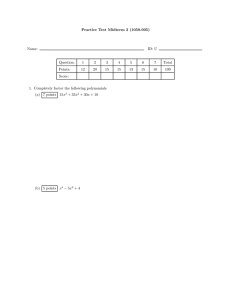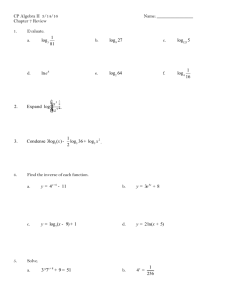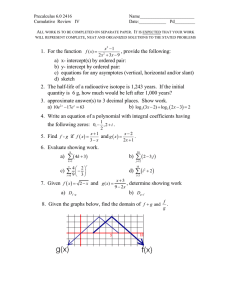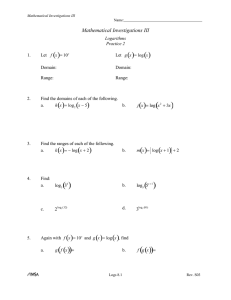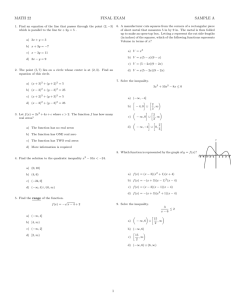Asymptotic Analysis of Run
advertisement
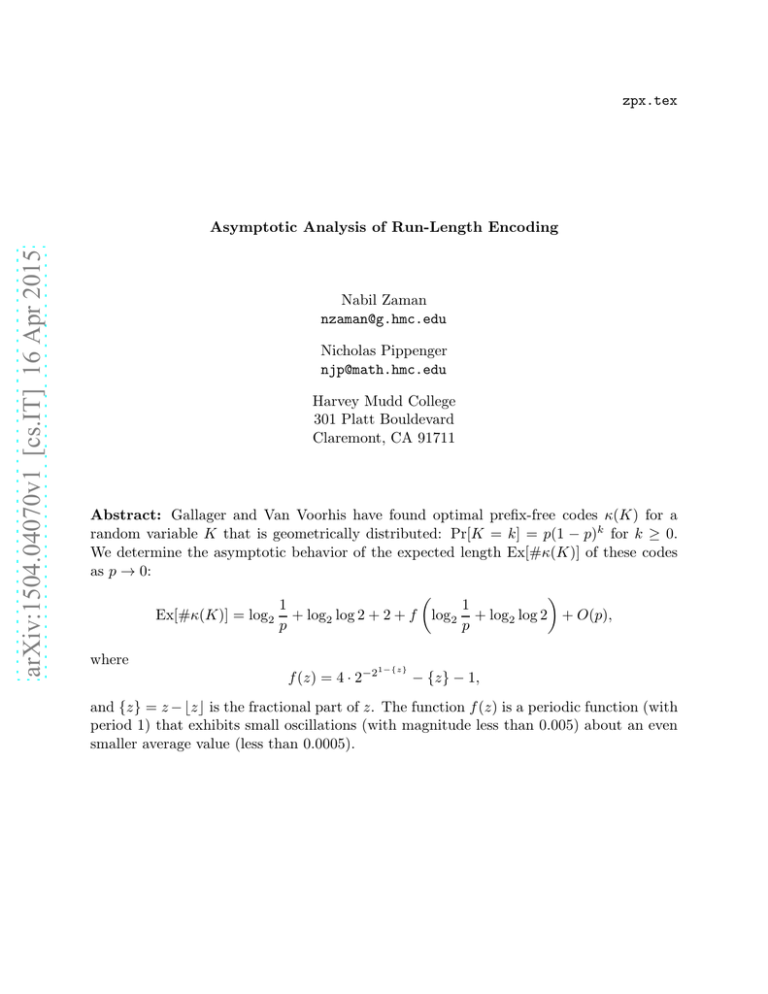
zpx.tex
arXiv:1504.04070v1 [cs.IT] 16 Apr 2015
Asymptotic Analysis of Run-Length Encoding
Nabil Zaman
nzaman@g.hmc.edu
Nicholas Pippenger
njp@math.hmc.edu
Harvey Mudd College
301 Platt Bouldevard
Claremont, CA 91711
Abstract: Gallager and Van Voorhis have found optimal prefix-free codes κ(K) for a
random variable K that is geometrically distributed: Pr[K = k] = p(1 − p)k for k ≥ 0.
We determine the asymptotic behavior of the expected length Ex[#κ(K)] of these codes
as p → 0:
1
Ex[#κ(K)] = log2 + log2 log 2 + 2 + f
p
where
f (z) = 4 · 2−2
1−{z}
1
log2 + log2 log 2 + O(p),
p
− {z} − 1,
and {z} = z − ⌊z⌋ is the fractional part of z. The function f (z) is a periodic function (with
period 1) that exhibits small oscillations (with magnitude less than 0.005) about an even
smaller average value (less than 0.0005).
1. Introduction
In 1975, Gallager and Van Voorhis [G1] (building on prior work by Golomb [G2])
found optimal prefix-free codes for a geometrically distributed random variable; that is, a
random variable K such that
Pr[K = k] = p(1 − p)k
(1.1)
for k ≥ 0, where 0 < p < 1 is a parameter. (This problem is sometimes referred to
as the “run-length encoding” problem, since the number of 0s between consecutive 1s
in a sequence of independent and identically distributed Bernoulli random variables is
geometrically distributed.) Their result shows that the optimal codes κ(K) have expected
codeword length Ex[#κ(K)]] close, but not equal, to the lower bound given by the entropy
Ex[#κ(K)] ≥ H(K)
X
=−
p(1 − p)k log2 p(1 − p)k
k≥0
1 1−p
+
log2 (1 − p)
p
p
1
= log2 + log2 e + O(p),
p
= log2
(1.2)
where log2 e = 1.442 . . . .
In Section 2, we shall show that
1
Ex[#κ(K)] = log2 + log2 log 2 + 2 + f
p
1
log2 + log2 log 2 + O(p),
p
(1.3)
where the function f (z) is a bounded periodic function of z with period 1. Specifically,
f (z) = 4 · 2−2
1−{z}
− {z} − 1,
with {z} = z − ⌊z⌋ denoting the fractional part of z. The function f (z) exhibits small
R1
oscillations about its average value ω = 0 f (z) dz = 4(log2 e) E1 (log 2) − E1 (2 log 2) −
R∞
3/2 = 0.0004547 . . . , where E1 (y) = y (e−x /x) dx. It assumes its largest value of f (z1 ) =
0.004195 . . . at z1 = 1+log2 log 2−log2 x1 = 0.7680 . . . , where x1 = 0.8140 . . . is the smaller
solution of the equation xe−x = (log2 e)/4, and its smallest value of f (z0 ) = −0.003438 . . .
at z0 = 1 + log2 log 2 − log2 x0 = 0.1934 . . . , where x0 = 1.2123 . . . is the larger solution
of that equation. Comparing this result with (1.2), we see that the average redundancy of
the optimal code is log2 log 2 + 2 + ω − log2 e = 0.02899 . . . .
1
2. Run-Length Encoding
According to Gallager and Van Voorhis [G1], the optimal prefix-free binary codes
for a geometric random variable K, distributed according to (1.1), can be constructed as
follows. Set
log(2 − p)
m=
.
− log(1 − p)
(2.1)
Divide K by m to obtain a quotient S ≥ 0 and a remainder 0 ≤ R ≤ m − 1:
K = Sm + R.
The distribution of S is geometric with parameter q = 1 − (1 − p)m ; that is
Pr[S = s] = (1 − q)q s
for s ≥ 0. The distribution of R is “truncated geometric”:
Pr[R = r] =
(1 − p)r
1 − (1 − p)m
(2.2)
for 0 ≤ r ≤ m − 1. We shall take optimal prefix-free codes σ(S) for S and ̺(R) for R, and
concatenate them (as strings) to obtain an optimal code κ(K) = σ(S) ̺(R).
√
Since (2.1) implies q ≥ (3 − 5)/2, an optimum prefix-free code for the quotient S is
σ(S) = 1S 0, and the expected length of this code is
Ex[#σ(S)] = Ex[S] + 1 =
1
1
=
.
q
1 − (1 − p)m
(2.3)
The optimum prefix-free code for the remainder R is a Huffman code ̺(R) (see Huffman [H]). We observe that the ratio between the smallest and the largest of the probabilities
given by (2.2) is (1 − p)m−1 . Since (2.1) implies that (1 − p)m−1 ≥ 1/(2 − p) > 1/2, it
follows that all of the codewords in this Huffman code must be of at most two consecutive
lengths. (If there were a codeword ξ of length i and two codewords η 0 and η 1 each of
length j ≥ i + 2, then the probability of ξ would be strictly smaller than the sum of the
probabilities of η 0 and η 1, and the code with η of length j − 1 and ξ 0 and ξ 1 each of
length i + 1 would have strictly smaller expected length.) Take
l = ⌊log2 m⌋
and
h = m − 2l ,
2
so that 0 ≤ h ≤ 2l − 1. Then there will be 2l − h codewords of length l and 2h codewords
of length l + 1. Since the 2h longer codewords will have the 2h smallest probabilities, the
expected codeword length for the Huffman code is
Ex[#̺(R)] = l +
X
m−2h≤k≤m−1
(1 − p)m−2h − (1 − p)m
(1 − p)k
=
l
+
.
1 − (1 − p)m
1 − (1 − p)m
Combining this expression for the expected length of the encoding of R with (2.3) for the
expected length of the encoding of S, we obtain
Ex[#κ(K)] = Ex[#σ(S)] + Ex[#̺(R)]
(1 − p)m−2h − (1 − p)m
1
=l+
+
m
1 − (1 − p)
1 − (1 − p)m
(2.4)
for the expected length of the encoding of K.
Since l and h are defined in terms of m, we shall start by eliminating them in favor of
ϑ = {log2 m},
the fractional part of log2 m. Then l = log2 m − ϑ, and from m = 2l + h we obtain
1 − 2h/m = 21−ϑ − 1. Substituting these expressions in (2.4) yields
1−ϑ
(1 − p)m(2 −1) − (1 − p)m
1
Ex[#κ(K)] = log2 m − ϑ +
+
1 − (1 − p)m
1 − (1 − p)m
(2.5)
Since ϑ is defined in terms of m, our next step will be to eliminate p in favor of m by using
the relation
log 2
m=
+ O(1),
(2.6)
p
which follows from (2.1) and implies
log 2
p=
+O
m
Thus
(1 − p)
m
1
m2
1
= +O
2
1
m
.
.
Substituting this expression in (2.5) yields
Ex[#κ(K)] = log2 m + 2 + f (log2 m) + O
3
1
m
,
(2.7)
where
f (z) = 4 · 2−2
1−{z}
− {z} − 1.
The function f is periodic with period 1. It is also continuous (because limz→1 f (z) =
f (0) = 0), and has a continuous derivative (because limz→1 f ′ (z) = f ′ (0) = 2(log 2)2 − 1).
These properties, combined with the relation
log2 m = log2
1
+ log2 log 2 + O(p)
p
which follows from (2.6), allow us to deduce
1
f (log2 m) = f log2 + log2 log 2 + O(p).
p
This in turn allows us to rewrite (2.7) in terms of p as
1
Ex[#κ(K)] = log2 + log2 log 2 + 2 + f
p
1
log2 + log2 log 2 + O(p).
p
It remains to examine the properties of the function f (z). The continuity of the periodic
function f (z) ensures that it is bounded, and the continuity of its derivative ensures that its
maxima and minima occur at values of z for which the derivative vanishes. The vanishing
of the derivative is given by the equation
1 = 4 · 2−2
1−ϑ
· 21−ϑ (log 2)2 .
The substitution x = 21−ϑ log 2 reduces this equation to x e−x = (log2 e)/4, from
which the numerical results mentioned in Section 1 follow. The same substitution
R1
also reduces the integral ω = 0 f (z) dz for the average value of f (z) to the integral
R 2 log 2
4(log2 e) log 2 (e−x /x) dx, leading again to the numerical results mentioned in Section 1.
We mention in closing that Wolf [W] has shown how to use some of the optimal prefixfree codes found by Gallager and Van Voorhis to construct asymptotically optimal nested
strategies for group testing. For this problem, the lower bound (applying to all strategies,
nested or not) to the expected number of tests per positive individual has the asymptotic
behavior indicated in (1.2). Thus the gap between (1.3) and (1.2) represents a bound to
the possible advantage that non-nested strategies might have over nested ones.
4
3. References
[G1] R. G. Gallager and D. C. Van Voorhis, “Optimal Source Codes for Geometrically
Distributed Integer Alphabets”, IEEE Trans. Information Theory, 21:2 (1975) 228–
229.
[G2] S. W. Golomb, “Run-Length Encodings”, IEEE Trans. Information Theory, 12:3
(1966) 399–401.
[H] D. Huffman, “A Method for the Construction of Minimum Redundancy Codes”, Proc.
IRE, 40 (1952) 1098–1103.
[W] J. Wolf, “Born Again Group Testing: Multiaccess Communications”, IEEE Trans.
Information Theory, 31:2 (1985) 185–191.
5


